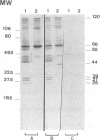Abstract
Human monocytic ehrlichiosis is caused by Ehrlichia chaffeensis, an intracellular bacterium probably transmitted by the tick Amblyomma americanum in the United States. Despite its lack of specificity in discriminating among infections by closely related Ehrlichia spp., immunofluorescence assay (IFA) is the most frequently used serological diagnostic method. To improve the specificity of the serological diagnosis, we compared antigenic profile of E. canis and E. chaffeensis antigen with homologous and heterologous sera, searching for the specificity of the presence of low-molecular-weight proteins. Western immunoblot analysis of IFA-positive human sera revealed 27- and 29-kDa proteins which are not found in E. canis IFA-positive sera from dogs. IFA-positive sera from dogs revealed a low-molecular-weight group of proteins (20 to 28 kDa) which were not found in human E. chaffeensis-positive sera except for a weak band at 22 kDa. The presence o antibodies directed against the 27- and 29-kDa proteins on Western blots is specific for E. chaffeensis infection, and we suggest that the Western blot might complete IFA in cases with low positive predictive value.
Full text
PDF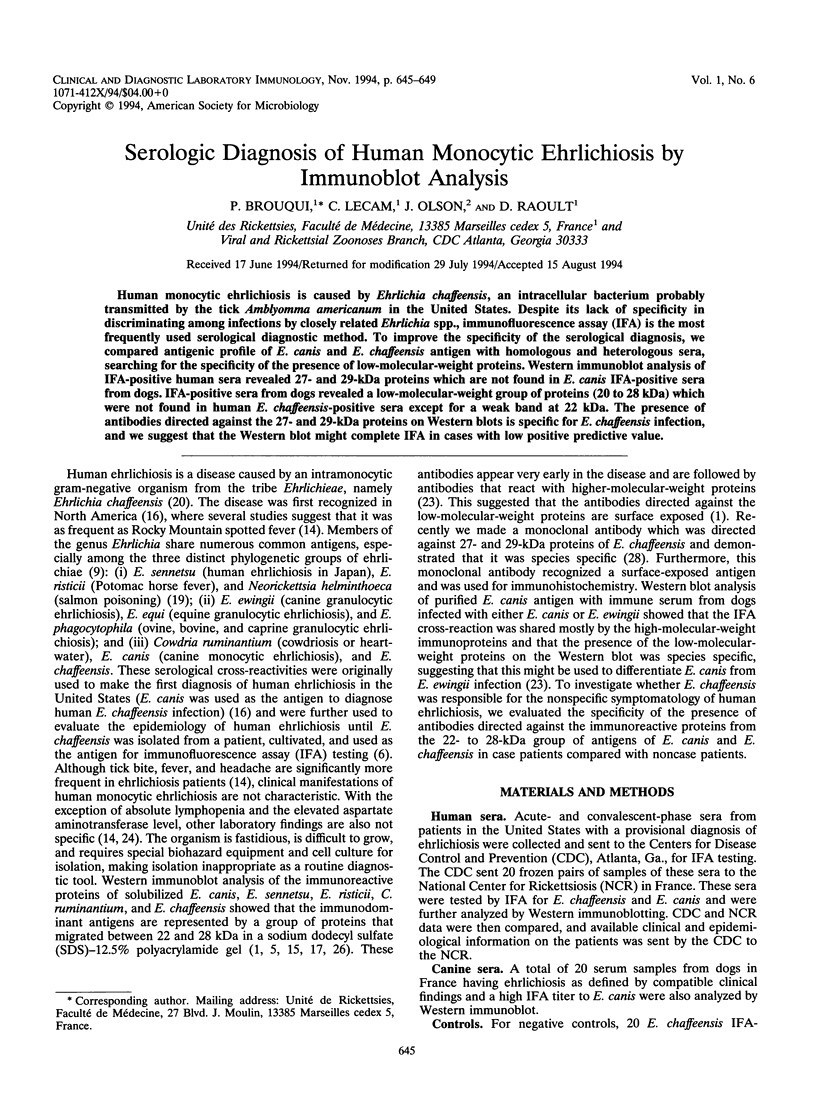
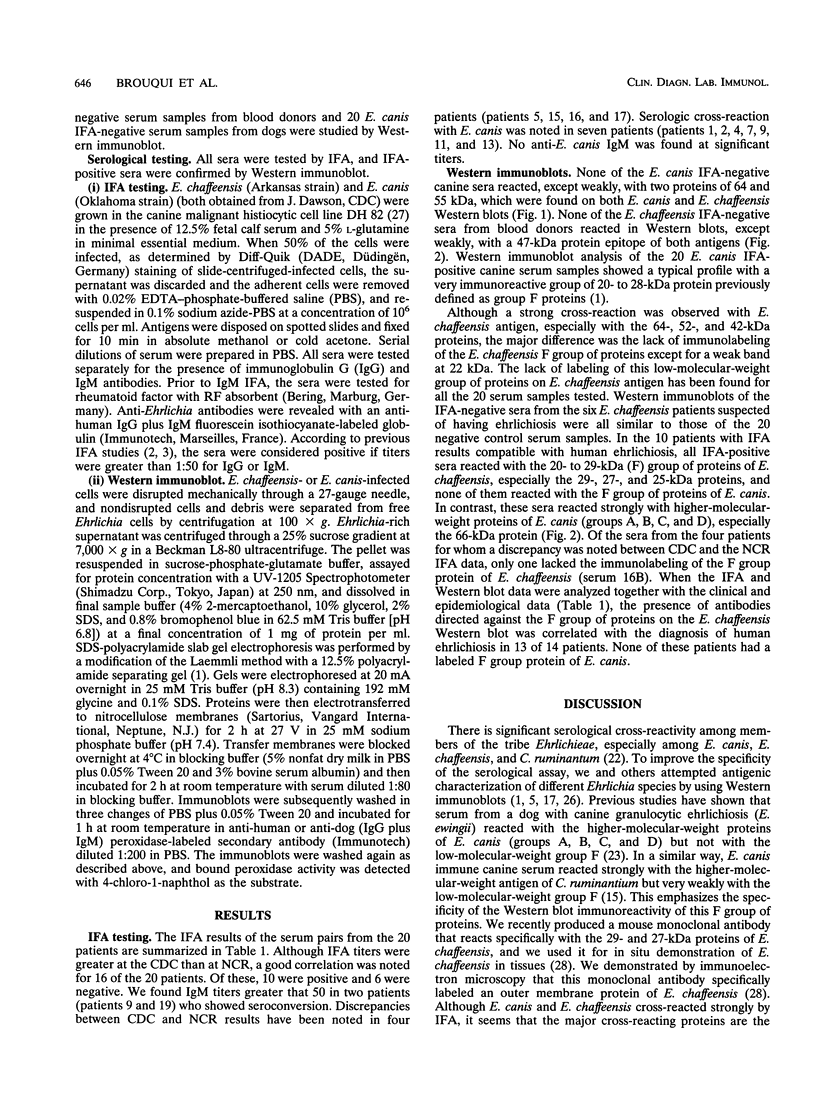
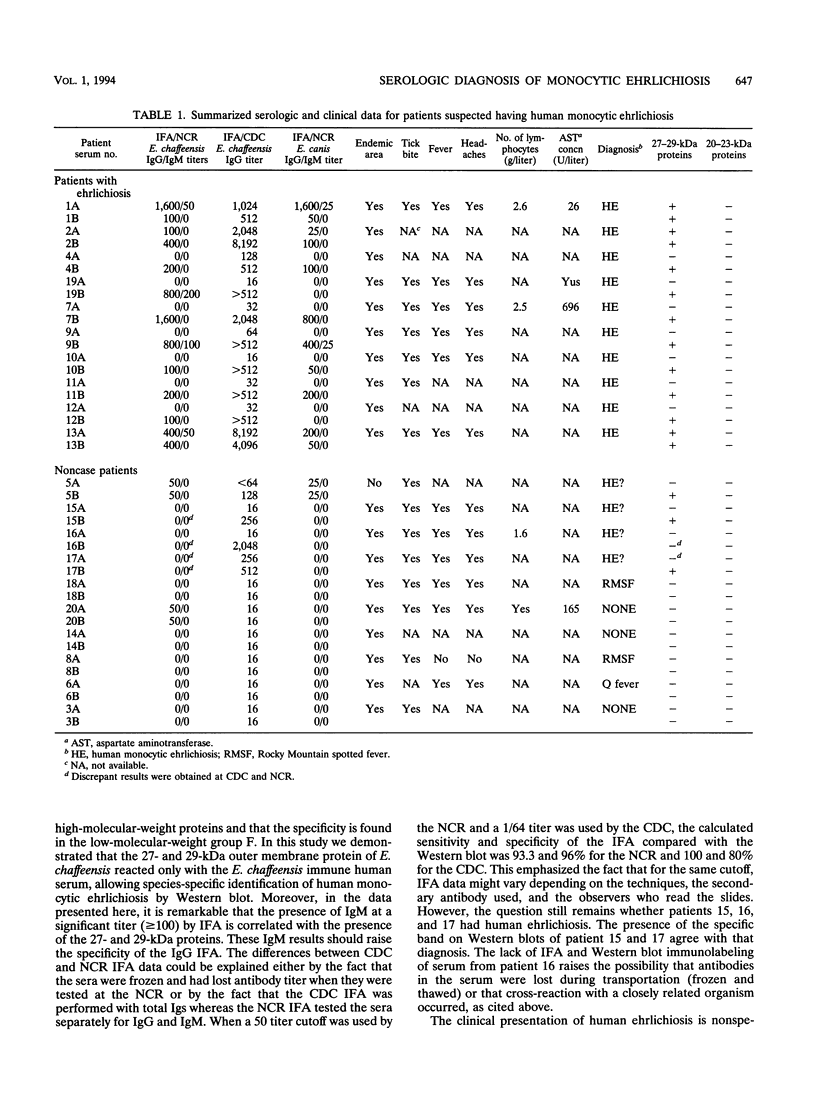
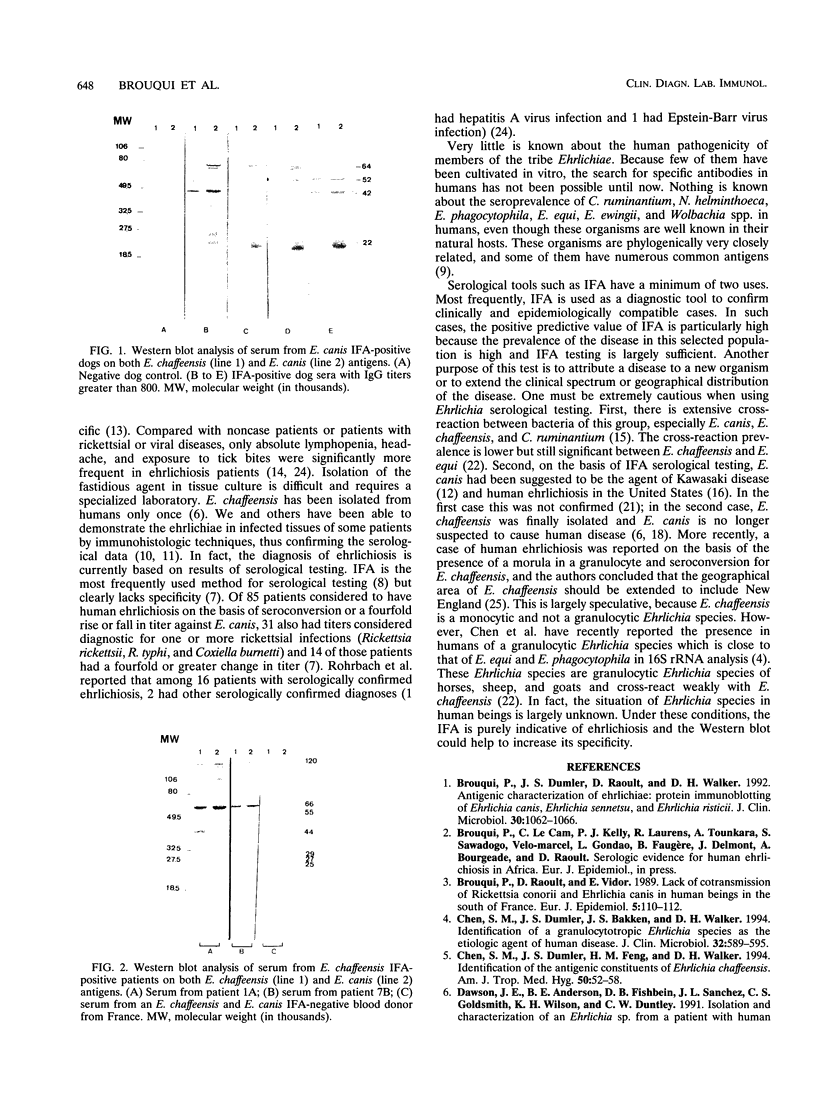
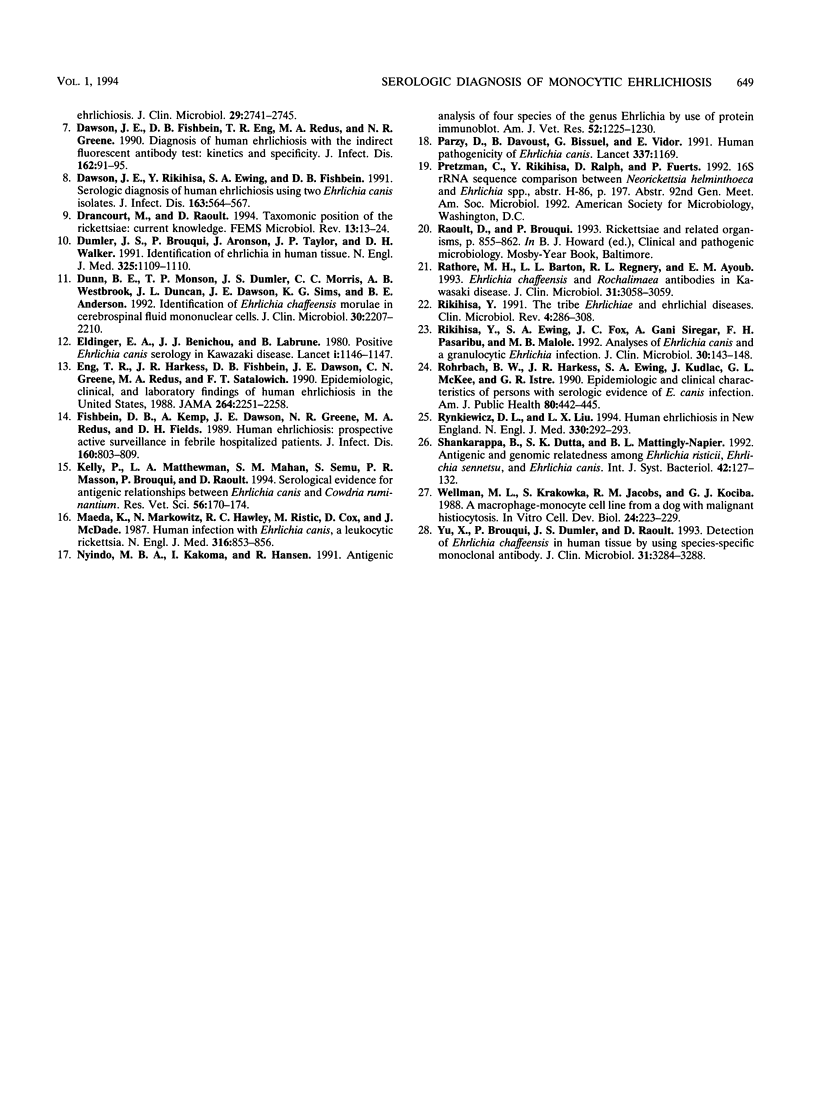
Images in this article
Selected References
These references are in PubMed. This may not be the complete list of references from this article.
- Brouqui P., Dumler J. S., Raoult D., Walker D. H. Antigenic characterization of ehrlichiae: protein immunoblotting of Ehrlichia canis, Ehrlichia sennetsu, and Ehrlichia risticii. J Clin Microbiol. 1992 May;30(5):1062–1066. doi: 10.1128/jcm.30.5.1062-1066.1992. [DOI] [PMC free article] [PubMed] [Google Scholar]
- Brouqui P., Raoult D., Vidor E. Lack of co-transmission of Rickettsia conorii and Ehrlichia canis in human beings in the south of France. Eur J Epidemiol. 1989 Mar;5(1):110–112. doi: 10.1007/BF00145056. [DOI] [PubMed] [Google Scholar]
- Chen S. M., Dumler J. S., Bakken J. S., Walker D. H. Identification of a granulocytotropic Ehrlichia species as the etiologic agent of human disease. J Clin Microbiol. 1994 Mar;32(3):589–595. doi: 10.1128/jcm.32.3.589-595.1994. [DOI] [PMC free article] [PubMed] [Google Scholar]
- Chen S. M., Dumler J. S., Feng H. M., Walker D. H. Identification of the antigenic constituents of Ehrlichia chaffeensis. Am J Trop Med Hyg. 1994 Jan;50(1):52–58. [PubMed] [Google Scholar]
- Dawson J. E., Anderson B. E., Fishbein D. B., Sanchez J. L., Goldsmith C. S., Wilson K. H., Duntley C. W. Isolation and characterization of an Ehrlichia sp. from a patient diagnosed with human ehrlichiosis. J Clin Microbiol. 1991 Dec;29(12):2741–2745. doi: 10.1128/jcm.29.12.2741-2745.1991. [DOI] [PMC free article] [PubMed] [Google Scholar]
- Dawson J. E., Fishbein D. B., Eng T. R., Redus M. A., Green N. R. Diagnosis of human ehrlichiosis with the indirect fluorescent antibody test: kinetics and specificity. J Infect Dis. 1990 Jul;162(1):91–95. doi: 10.1093/infdis/162.1.91. [DOI] [PubMed] [Google Scholar]
- Dawson J. E., Rikihisa Y., Ewing S. A., Fishbein D. B. Serologic diagnosis of human ehrlichiosis using two Ehrlichia canis isolates. J Infect Dis. 1991 Mar;163(3):564–567. doi: 10.1093/infdis/163.3.564. [DOI] [PubMed] [Google Scholar]
- Drancourt M., Raoult D. Taxonomic position of the rickettsiae: current knowledge. FEMS Microbiol Rev. 1994 Jan;13(1):13–24. doi: 10.1111/j.1574-6976.1994.tb00032.x. [DOI] [PubMed] [Google Scholar]
- Dumler J. S., Brouqui P., Aronson J., Taylor J. P., Walker D. H. Identification of Ehrlichia in human tissue. N Engl J Med. 1991 Oct 10;325(15):1109–1110. doi: 10.1056/NEJM199110103251517. [DOI] [PubMed] [Google Scholar]
- Dunn B. E., Monson T. P., Dumler J. S., Morris C. C., Westbrook A. B., Duncan J. L., Dawson J. E., Sims K. G., Anderson B. E. Identification of Ehrlichia chaffeensis morulae in cerebrospinal fluid mononuclear cells. J Clin Microbiol. 1992 Aug;30(8):2207–2210. doi: 10.1128/jcm.30.8.2207-2210.1992. [DOI] [PMC free article] [PubMed] [Google Scholar]
- Edlinger E. A., Benichou J., Labrune B. Positive Ehrlichia canis serology in Kawasaki disease. Lancet. 1980 May 24;1(8178):1146–1147. doi: 10.1016/s0140-6736(80)91603-7. [DOI] [PubMed] [Google Scholar]
- Eng T. R., Harkess J. R., Fishbein D. B., Dawson J. E., Greene C. N., Redus M. A., Satalowich F. T. Epidemiologic, clinical, and laboratory findings of human ehrlichiosis in the United States, 1988. JAMA. 1990 Nov 7;264(17):2251–2258. [PubMed] [Google Scholar]
- Fishbein D. B., Kemp A., Dawson J. E., Greene N. R., Redus M. A., Fields D. H. Human ehrlichiosis: prospective active surveillance in febrile hospitalized patients. J Infect Dis. 1989 Nov;160(5):803–809. doi: 10.1093/infdis/160.5.803. [DOI] [PubMed] [Google Scholar]
- Kelly P. J., Matthewman L. A., Mahan S. M., Semu S., Peter T., Mason P. R., Brouqui P., Raoult D. Serological evidence for antigenic relationships between Ehrlichia canis and Cowdria ruminantium. Res Vet Sci. 1994 Mar;56(2):170–174. doi: 10.1016/0034-5288(94)90100-7. [DOI] [PubMed] [Google Scholar]
- Maeda K., Markowitz N., Hawley R. C., Ristic M., Cox D., McDade J. E. Human infection with Ehrlichia canis, a leukocytic rickettsia. N Engl J Med. 1987 Apr 2;316(14):853–856. doi: 10.1056/NEJM198704023161406. [DOI] [PubMed] [Google Scholar]
- Nyindo M., Kakoma I., Hansen R. Antigenic analysis of four species of the genus Ehrlichia by use of protein immunoblot. Am J Vet Res. 1991 Aug;52(8):1225–1230. [PubMed] [Google Scholar]
- Parzy D., Davoust B., Bissuel G., Vidor E. Human pathogenicity of Ehrlichia canis. Lancet. 1991 May 11;337(8750):1169–1169. doi: 10.1016/0140-6736(91)92843-q. [DOI] [PubMed] [Google Scholar]
- Rathore M. H., Barton L. L., Dawson J. E., Regnery R. L., Ayoub E. M. Ehrlichia chaffeensis and Rochalimaea antibodies in Kawasaki disease. J Clin Microbiol. 1993 Nov;31(11):3058–3059. doi: 10.1128/jcm.31.11.3058-3059.1993. [DOI] [PMC free article] [PubMed] [Google Scholar]
- Rikihisa Y., Ewing S. A., Fox J. C., Siregar A. G., Pasaribu F. H., Malole M. B. Analyses of Ehrlichia canis and a canine granulocytic Ehrlichia infection. J Clin Microbiol. 1992 Jan;30(1):143–148. doi: 10.1128/jcm.30.1.143-148.1992. [DOI] [PMC free article] [PubMed] [Google Scholar]
- Rikihisa Y. The tribe Ehrlichieae and ehrlichial diseases. Clin Microbiol Rev. 1991 Jul;4(3):286–308. doi: 10.1128/cmr.4.3.286. [DOI] [PMC free article] [PubMed] [Google Scholar]
- Rohrbach B. W., Harkess J. R., Ewing S. A., Kudlac J., McKee G. L., Istre G. R. Epidemiologic and clinical characteristics of persons with serologic evidence of E. canis infection. Am J Public Health. 1990 Apr;80(4):442–445. doi: 10.2105/ajph.80.4.442. [DOI] [PMC free article] [PubMed] [Google Scholar]
- Rynkiewicz D. L., Liu L. X. Human ehrlichiosis in New England. N Engl J Med. 1994 Jan 27;330(4):292–293. doi: 10.1056/NEJM199401273300418. [DOI] [PubMed] [Google Scholar]
- Shankarappa B., Dutta S. K., Mattingly-Napier B. L. Antigenic and genomic relatedness among Ehrlichia risticii, Ehrlichia sennetsu, and Ehrlichia canis. Int J Syst Bacteriol. 1992 Jan;42(1):127–132. doi: 10.1099/00207713-42-1-127. [DOI] [PubMed] [Google Scholar]
- Wellman M. L., Krakowka S., Jacobs R. M., Kociba G. J. A macrophage-monocyte cell line from a dog with malignant histiocytosis. In Vitro Cell Dev Biol. 1988 Mar;24(3):223–229. doi: 10.1007/BF02623551. [DOI] [PubMed] [Google Scholar]
- Yu X., Brouqui P., Dumler J. S., Raoult D. Detection of Ehrlichia chaffeensis in human tissue by using a species-specific monoclonal antibody. J Clin Microbiol. 1993 Dec;31(12):3284–3288. doi: 10.1128/jcm.31.12.3284-3288.1993. [DOI] [PMC free article] [PubMed] [Google Scholar]




